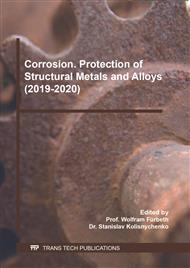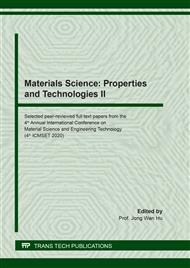[1]
D. Raps, T. Hack, J. Wehr, M. L. Zheludkevich, A. C. Bastos, M. G. S. Ferreira, O. Nuyken, Electrochemical study of inhibitor-containing organic–inorganic hybrid coatings on AA2024, Corros. Sci. 51(5) (2009) 1012-1021.
DOI: 10.1016/j.corsci.2009.02.018
Google Scholar
[2]
N. Boshkova, N. Tabakova, G. Atanassova, N. Boshkov, Electrochemical Obtaining and Corrosion Behavior of Zinc-Polyaniline (Zn-PANI) Hybrid Coatings, Coatings , 9(8) (2019), 487.
DOI: 10.3390/coatings9080487
Google Scholar
[3]
R. Fuchs-Godec, The adsorption, CMC determination and corrosion inhibition of some N-alkyl quaternary ammonium salts on carbon steel surface in 2M H2SO4, Colloids Surf. A: Physicochem. Eng. Aspects, 280(1-3) (2006) 130-139.
DOI: 10.1016/j.colsurfa.2006.01.046
Google Scholar
[4]
A. Jenkins, N. Grainger, M. Blezard, M. Pepin, Quaternary ammonium corrosion inhibitors, U.S. Patent 9,103,039. (2015).
Google Scholar
[5]
M. Stern, A. L. Geary, Electrochemical polarization I. A theoretical analysis of the shape of polarizationcurves, J. Electrochem. Soc.104 (1957) 56-63.
DOI: 10.1149/1.2428473
Google Scholar
[6]
M. M. J. Oosthuizen , D. Greyling, Antioxidants suitable for use with chemiluminescence to identify oxyradical species, Redox Report, 4(6) (1999) 277-290.
DOI: 10.1179/135100099101535124
Google Scholar
[7]
J. Tang, Y. Hu, Z. Han, H. Wang, Y. Zhu, Y. Wang, Z. Nie, Y. Wang, Experimental and Theoretical Study on the Synergistic Inhibition Effect of Pyridine Derivatives and Sulfur-Containing Compounds on the Corrosion of Carbon Steel in CO2-Saturated 3.5 wt.% NaCl Solution, Molecules, 23 (2018) 3270.
DOI: 10.3390/molecules23123270
Google Scholar
[8]
I. Rosenthal, A. Frimer, The Quenching Effect of Iodide Ion on Singlet Oxygen, Photochem. Photobiol. 23 (1976) 209-211.
DOI: 10.1111/j.1751-1097.1976.tb07244.x
Google Scholar
[9]
A. Gollmer, A. Felgenträger, W. Bäumler, T. Maisch, A. Späth, A novel set of symmetric methylene blue derivatives exhibits effective bacteria photokilling – a structure–response study, Photochem. Photobiol. Sci. 14 (2015) 335-351.
DOI: 10.1039/c4pp00309h
Google Scholar
[10]
P. Ballester, A. Oliva, A. Costa, P. Deyà, A. Frontera, R. Gomila, C. Hunter, DABCO-Induced Self-Assembly of a Trisporphyrin Double-Decker Cage: Thermodynamic Characterization and Guest Recognition, J. Am. Chem. Soc. 128(16) (2006) 5560-5569.
DOI: 10.1021/ja060608t
Google Scholar
[11]
K. A. H. Alzahrani, R. J. Deeth, Molecular modeling of zinc paddlewheel molecular complexes and the pores of a flexible metal organic framework, J. Mol. Model, 22(4) (2016) 80.
DOI: 10.1007/s00894-016-2949-5
Google Scholar
[12]
Y. Qu, L. Su, J. Wu, Synthesis and Crystal Structure of Copper II and Silver I Complex with 1,4-diazabicyclo [2.2.2] octane[Cu(CBC)2(Dabco)(H2O)] n (1) and [Ag2(HBC)2(Dabco)] n (2), J. Chem. Crystallogr. 37 (2007) 579-582.
DOI: 10.1007/s10870-007-9214-9
Google Scholar



